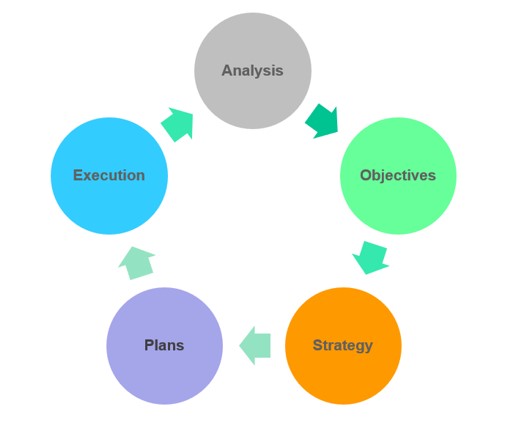Version française/French version: LINK
This article proposes a structured approach for formulating and implementing the development strategy of your company. It outlines five steps, starting from the analysis of your company and its environment to the execution of the strategy, accompanied by recommendations such as involving all stakeholders, conducting on-the-ground analysis, considering sector trends, and regularly communicating successes. The emphasis is on the flexibility of the process to adapt to changes in your environment.
E. Krieger

Formulating the development strategy of a company is a crucial step to ensure its growth and sustainability. This work, primarily the responsibility of your board of directors, CEO, and executive committee, should involve most stakeholders. If not, there is a risk of building a top-down strategy and struggling with its implementation.
Here is a simplified framework that can structure your approach to formulating and implementing your development strategy:

1] Analyze your company and its environment
- Evaluate the strategic capabilities of your company to identify resources, skills, strengths, and weaknesses.
- Analyze the external environment by identifying opportunities and threats for your company, as well as key success factors in your sector.
- Summarize your analysis through a SWOT synthesis (Strengths, Weaknesses, Opportunities, and Threats) and formulate your diagnosis and prognosis: where can we go, and where do we want to go?
2] Define your Objectives
- Develop a clear vision of your company in the medium and long term.
- Establish high-level goals as well as SMART objectives: Specific, Measurable, Achievable, Realistic, and Time-bound.
- Specify your contribution in terms of social and environmental impact.
3] Formulate your development Strategy
- Define one or more priority segments by focusing on needs not well satisfied by existing offerings.
- Identify what sets you apart from your main competitors to forge a sustainable, defensible competitive advantage valued by your customers.
- Define your strategic development paths: geographical, technological, commercial diversification, upstream or downstream integration.
4] Develop operational Plans
- Develop well-documented and phased action plans to achieve your objectives: R&D, Marketing/Sales, Production/Logistics, Human Resources, Finance, etc.
- Define responsibilities and delegations in decision-making.
- Optimize the use of existing resources and mobilize the complementary resources required: human, technological, financial, etc.
5] Execute your strategy and monitor your achievements
- Communicate your strategy at all levels of the company and implement it by seeking the buy-in of all stakeholders.
- Establish key performance indicators to measure progress.
- Conduct regular evaluations to adjust the strategy if necessary.
Flexibility is essential in this iterative process because your environment will evolve, requiring adjustments to your strategy.
Here are some recommendations to facilitate this exercise of formulating and implementing your development strategy:
- Involve all your teams in the on-the-ground analysis process and in setting mobilizing objectives by providing clear and motivating mechanisms for sharing the created value.
- Start from the ground: your external analysis will benefit from relying on economic statistics and other secondary data, but nothing replaces on-the-ground studies (primary data) to give substance to your development plan.
- Analyze the social, cultural, economic, political, technological, environmental, and legal trends shaping the evolution of your sector. This foresight exercise helps identify particularly fruitful development options.
- Carefully craft your value proposition; otherwise, your entire economic structure may become an energy dissipation machine.
- Consider the scalability of your business model: what would it take to multiply your revenues or profits tenfold? Thinking about such scaling will help identify bottlenecks and adapt your business model.
- Quantify! For a business model to be relevant, it must be accompanied by forecast accounts (value equation), allowing you to steer your company based on its operating cash flows and key indicators.
- Your values will be a filter and an amplifier of performance! Ensure that your vision and objectives align with the fundamental values of your company.
- Communicate regularly and celebrate successes that validate the relevance of your development strategy and its quality of execution. This will be an effective way to mobilize talents without which such a strategic process would remain a dead letter.
Good luck with this exercise of formulating and implementing your development strategy!


